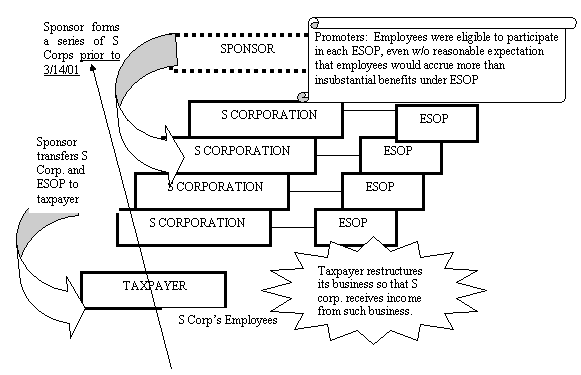LISTED TRANSACTIONS
Listed Transaction #19
(Abusive Use of ESOP/S)
Abusive Use of ESOP/S Corp. Arrangements to
Avoid Anti-Abuse Section 409(p) Effective Date
IRS Rev. Ruling 2003-6

According to the IRS, for purposes of determining whether an ESOP/S corp. arrangement qualifies for a delayed effective date with respect to the new synthetic equity/ESOP rules [see also, Rev. Ruling 2004-4 (Listed Transaction #27)], an ESOP is not properly established until it is adopted by an employer for the purpose of enabling its employees to participate in a more than insubstantial manner in the ownership of the employer’s business and to provide its employees with more than insubstantial benefits under the ESOP. Consequently, the IRS concluded that the ESOPs set up by the sponsor in the ruling were not eligible for the delayed effective date of the new law (Section 656 of the Economic Growth and Tax Relief Reconciliation Act of 2001, amending Sections 409 and 4979(a) of the Internal Revenue Code, applicable generally to plan years beginning after 12/31/2004). This new law and its legislative history suggest that Section 409(p) of the Internal Revenue Code is intended to limit the establishment of ESOPs by S corporations to those that provide broad-based employee coverage and that benefit rank-and-file employees as well as highly compensated employees and historical owners.
Abusive Management Company/Ownership Structures
Congress is concerned about techniques which are aimed at trying to avoid or evade these requirements, such as through the development of complex ownership structures. For example, take a profitable C corporation owned by a small group of owners/employees. These owners might create a new corporation (NEWCO) with the purpose of having it serve as a management company. They and all of the employees of the operating company would become employees of the management company, with the management company paying the owners a salary and establish deferred compensation arrangements for these owners. The management company then makes a S election and establishes an ESOP that would own 100% of the stock of the management company (usually the stock is contributed or sold to the ESOP for a nominal amount). The ESOP covers all of the management company employees and could exclude the owners of the operating company from receiving benefits.
The operating company (C corporation) takes a deduction for the management fees paid to the management company. The management company uses the fees to pay compensation to the owners and the other employees, with the balance to “fund” the management company’s deferred compensation arrangements. The management fees are taxable income to the management company, but the excess over that paid to employees (including those paid to the former owners of the operating company) is not subject to tax because the management company is an S corporation owned by the ESOP. This enables the funds to accumulate on a tax-free basis until they are paid to the former owners of the management company under the deferred compensation arrangement. Section 409(p) is designed to prevent this type of scheme from succeeding.
NOTE: Over the past year, the IRS has issued regulations which need to be examined closely. Many S Corporations with ESOPs might inadvertently violate Section 409.
If you believe that you may have engaged in a transaction that is the same or substantially similar to the transaction described above, Federal law may require you to disclose your and other parties’ participation in any such “listed transaction” on IRS Form 8886. For more information about Federal law requirements, please contact us.
